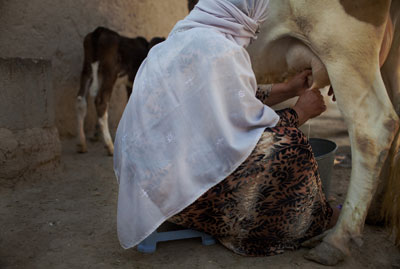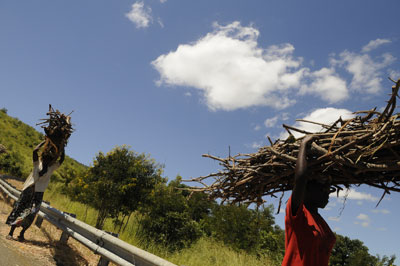International Day of Rural Women
15 October 2009 |



|
 |

|
Cultivating better lives: rural women and world food security
Women play a critical role in the rural economies of both developed and developing countries. In most parts of the developing world they participate in crop production and livestock care, provide food, water and fuel for their families, and engage in off-farm activities to diversify the family income. In addition, they carry out vital functions in caring for children, older persons and the sick. According to the International Labour Organization (ILO), 428 million women work in the agricultural sector around the world, compared to 608 million men. In many parts of the world, agriculture is the first sector of employment for women, for instance in Sub-Saharan Africa and in South Asia, where respectively 68 per cent and 61 per cent of working women are employed in agriculture. 1 |
After Liberia’s civil war ended in 2003, Rebecca Benson answered her government’s call to go back to the land, by taking up rural farming after the conflict. Liberia was counting on agriculture to help rebuild the national economy and decrease its dependence on costly rice imports.
Benson cultivates mostly rice and rubber on 22 hectares of land in northern Liberia and has won national prizes for her upland rice crop. Thanks to the efforts of farmers like her, Liberia has seen its rice production increase in the past few years, though the country is still grappling with widespread hunger and poverty.
“It’s a struggle with all the constraints,” says Benson, a mother of two. She says limited cash and poor roads hamper the efforts of local farmers to transport and market their products. “But I feel very proud of what I have done.”
| |  |
| |
Dairy operation in Afghanistan. ©FAO/Danfung Dennis |
In rural communities worldwide, women play a key role in agricultural production and income generation.
In sub-Saharan Africa and the Caribbean, women produce up to 80 percent of basic foodstuffs, and in Southeast Asia, women account for up to 90 percent of the labour that goes into rice cultivation.2
But, unlike Benson, many toil away without receiving recognition or practical support for their efforts. Worldwide, women in agriculture are less likely than men to have access to land, equipment, credit, training and other tools which could help them to improve their food security and livelihoods. In Cameroon, women perform more than 75 percent of all agricultural labour, yet they hold less than 10 percent of the land titles. 3
Many of the tasks which rural women perform, though indispensable, are difficult to quantify, such as clearing land and sowing seeds, gathering wild plants for food and medicine, hauling water and wood, and keeping small livestock for household use. This, combined with deeply ingrained societal biases which place little value on women’s work, can render the contributions of rural women virtually invisible.
The lack of recognition for women’s responsibilities often extends to the additional stresses and hazards which they face, such as the loss of livelihood when sexual violence leaves them injured or afraid to return to the fields. Many women are overburdened when their multiple agricultural responsibilities are combined with their roles as mothers and family caretakers.
“Narrowing the gap between the general perception of rural women and their actual contributions and needs is essential to reducing hunger and improving lives in rural, developing areas, which are home to 70 percent of the world’s poor and hungry men, women and children,” says Eve Crowley, Principal Advisor in the Gender, Equity and Rural Employment Division at the Food and Agriculture Organization of the United Nations (FAO).
 |
| | Women carrying wood in Malawi. ©FAO/Eddie Gerald |
|
As the UN’s lead agency for agricultural and rural development, FAO is in the midst of hosting a series of high-level encounters on the increasing numbers of hungry people in the world. The events, which will culminate in the 16-18 November, 2009 World Summit on Food Security, present a vital opportunity for experts, policy makers and civil-society organizations to develop more effective and sustainable agricultural and rural development policies.
“One of the cross-cutting issues to be reckoned with at every level in rural development is how social and economic inequalities between men and women can stand in the way of food security for an entire household, nation or region.” says Crowley.
“We need to look at how gender differences can be taken into account to enhance the access which both rural men and women have to essential resources and opportunities to improve food security and sustainable agriculture.”
FAO Report on the State of Food Insecurity: http://www.fao.org/docrep/012/i0876e/i0876e00.htm
|
Observances of International Day of Rural Women
The International Day of Rural Women directs attention to both the contribution that women make in rural areas, and the many challenges that they face. This new international day, established by the General Assembly in its resolution 62/136 of 18 December 2007, recognizes “the critical role and contribution of rural women, including indigenous women, in enhancing agricultural and rural development, improving food security and eradicating rural poverty.” In 2007, at the tenth session of the Regional Conference on Women in Latin America and the Caribbean, Member States of the Economic Commission for Latin America and the Caribbean, expressed in the Quito Consensus their decision to promote the adoption of an International Day of Rural Women “as an explicit recognition of [rural women’s] economic contribution and the development of their communities, in particular with regard to the unpaid work they perform.”12
The idea of honouring rural women with a special day was put forward by international NGOs at the Fourth World Conference on Women in Beijing in 1995. It was suggested that 15 October be celebrated as “World Rural Women’s Day,” on the eve of World Food Day, in order to highlight the role played by rural women in food production and food security.
“World Rural Women’s Day” has been celebrated, primarily by civil society, across the world for over a decade. The first International Day of Rural Women was observed in New York on 15 October 2008.
Previous years' observances:
» International Day of Rural Women 2008
|
|
|


